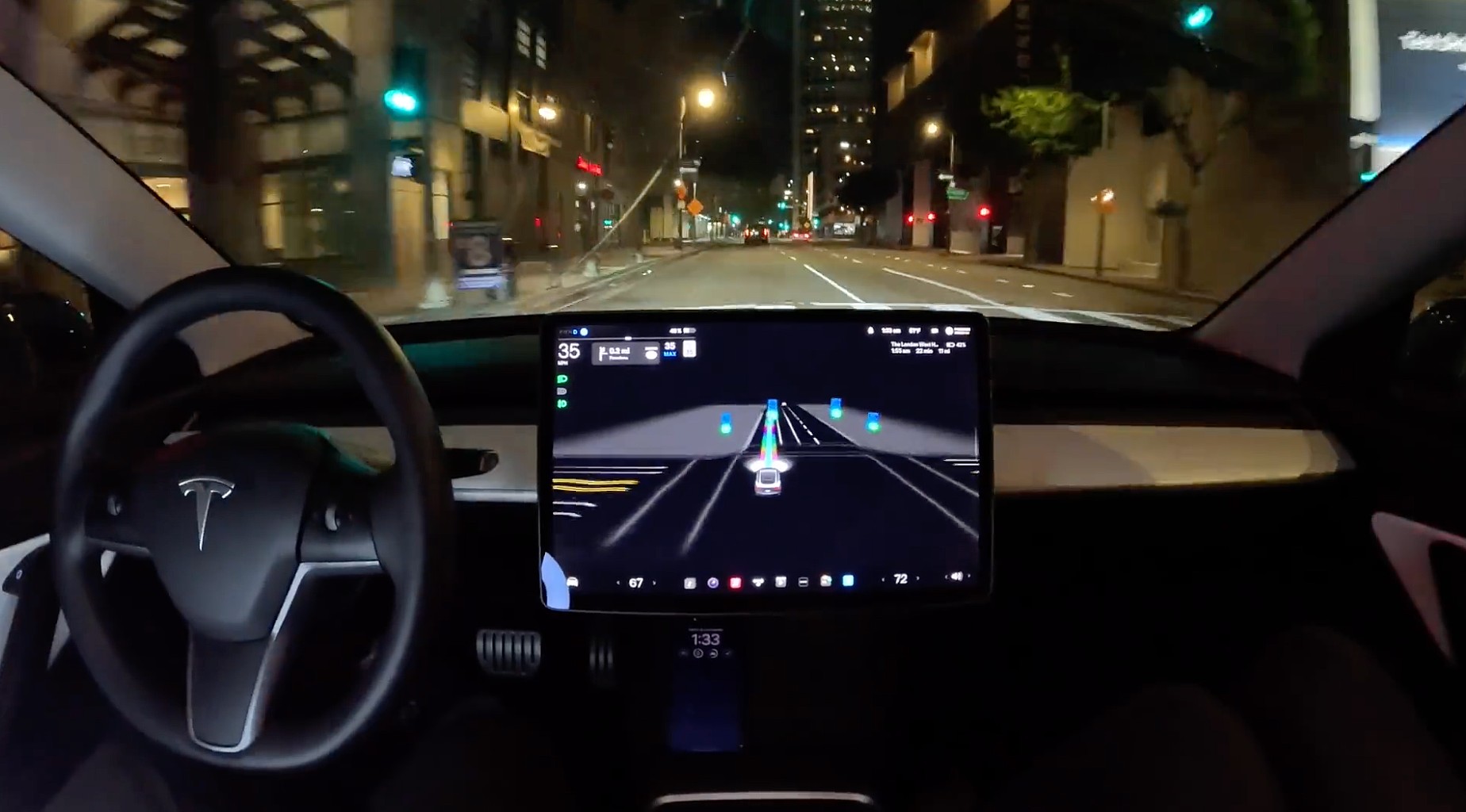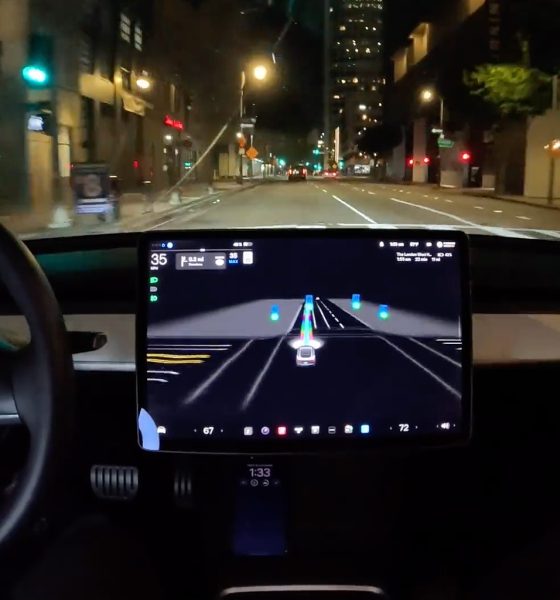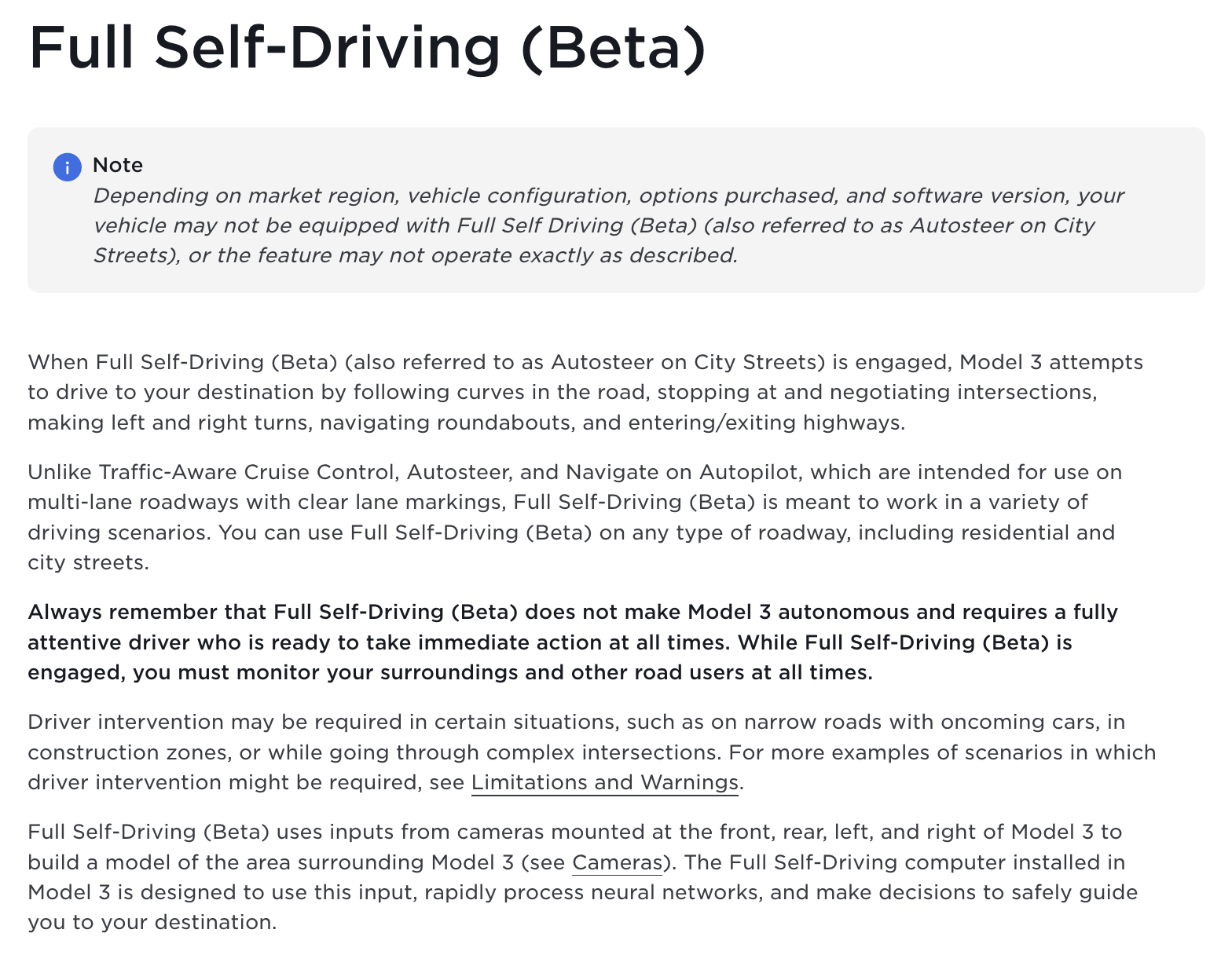

News
Tesla owner’s manuals outside North America hint at FSD beta rollout
Tesla has begun including Full Self-Driving (FSD) beta information in some of its newer owner’s manuals across Europe, China and Australia, further suggesting that the automaker may be inching toward a release of the system beyond North America.
The FSD beta was spotted being tested in Australia and Europe by just a few vehicles earlier this year, and Tesla has been ramping up hiring for the system in China in the past few months. In addition, China debuted a smart expressway for self-driving last month, designed for the use of up to Level 4 driving automation.
On Saturday, Tesla software observer Teslascope pointed out that the automaker has been hinting at the deployment of its FSD beta beyond North America, as details about the software can now be found in newer vehicle manuals from the company in Europe, China, Australia and elsewhere.
Although Tesla has been testing the software outside of North America for years, Teslascope notes that the FSD beta will still require regulatory approval in many countries, even as U.S. officials continue to navigate how to create a regulatory framework around self-driving software.
As a reminder with today’s “hinting” to Full Self-Driving (Beta) outside of North America within Owner’s Manuals, Tesla has been testing their autonomous suite for 2+ years now.
Many countries will require regulator approval, however, we remain confident in expansion soon. https://t.co/tyOkA5jDvN
— Teslascope (@teslascope) November 18, 2023
Credit: Tesla | Model 3 Owner’s Manual in Europe
It’s still not clear when Tesla will be rolling the FSD beta out publicly in these regions, though the addition of the system to its owner’s manuals is definitely not a bad thing.
Other sources have also claimed that Tesla’s FSD beta is set to enter the Chinese market, adding that the company is just waiting to announce the news.
https://twitter.com/bentv_sh/status/1725906555361808877
In each of the owner’s manuals, Tesla notes that “Depending on market region, vehicle configuration, options purchased, and software version, your vehicle may not be equipped with Full Self Driving (Beta) (also referred to as Autosteer on City Streets), or the feature may not operate exactly as described.”
The automaker also details plans to roll the feature out to customers beyond North America gradually, as can be seen below from the manuals.
“As Full Self-Driving (Beta) deployment expands, Tesla will gradually make it available to eligible customers in select countries outside of the United States and Canada,” the automaker writes.
“Because every country contains unique infrastructure, driving behaviors, and traffic patterns that Full Self-Driving (Beta) must adapt to over time, it is essential for drivers using Full Self-Driving (Beta) in newly eligible countries to be extra attentive and overly cautious. You must be ready to take over safely at any time.”
The company also notes that its FSD beta is a “hands-on feature that requires you to pay attention to the road at all times,” rather than offering higher levels of automation that would allow the driver to stop monitoring road conditions.
Last month, Tesla’s FSD beta program reached half a billion cumulative miles driven, ahead of the company’s release of the system’s version 12 in North America, which reportedly will no longer be a beta, according to CEO Elon Musk. It’s not clear exactly when the release will take place, though it’s expected to come soon.
In what seemed to be a joke tinged with self-awareness around Tesla’s failure to stick to rollout deadlines and his many prior claims that software would be released in just two weeks, Musk last week said customers might be able to try out FSD version 12 in “about 2 weeks.”
What are your thoughts? Let me know at zach@teslarati.com, find me on X at @zacharyvisconti, or send your tips to us at tips@teslarati.com.

News
Tesla FSD fleet is nearing 7 billion total miles, including 2.5 billion city miles
As can be seen on Tesla’s official FSD webpage, vehicles equipped with the system have now navigated over 6.99 billion miles.

Tesla’s Full Self-Driving (Supervised) fleet is closing in on almost 7 billion total miles driven, as per data posted by the company on its official FSD webpage.
These figures hint at the massive scale of data fueling Tesla’s rapid FSD improvements, which have been quite notable as of late.
FSD mileage milestones
As can be seen on Tesla’s official FSD webpage, vehicles equipped with the system have now navigated over 6.99 billion miles. Tesla owner and avid FSD tester Whole Mars Catalog also shared a screenshot indicating that from the nearly 7 billion miles traveled by the FSD fleet, more than 2.5 billion miles were driven inside cities.
City miles are particularly valuable for complex urban scenarios like unprotected turns, pedestrian interactions, and traffic lights. This is also the difference-maker for FSD, as only complex solutions, such as Waymo’s self-driving taxis, operate similarly on inner-city streets. And even then, incidents such as the San Francisco blackouts have proven challenging for sensor-rich vehicles like Waymos.
Tesla’s data edge
Tesla has a number of advantages in the autonomous vehicle sector, one of which is the size of its fleet and the number of vehicles training FSD on real-world roads. Tesla’s nearly 7 billion FSD miles then allow the company to roll out updates that make its vehicles behave like they are being driven by experienced drivers, even if they are operating on their own.
So notable are Tesla’s improvements to FSD that NVIDIA Director of Robotics Jim Fan, after experiencing FSD v14, noted that the system is the first AI that passes what he described as a “Physical Turing Test.”
“Despite knowing exactly how robot learning works, I still find it magical watching the steering wheel turn by itself. First it feels surreal, next it becomes routine. Then, like the smartphone, taking it away actively hurts. This is how humanity gets rewired and glued to god-like technologies,” Fan wrote in a post on X.
News
Tesla starts showing how FSD will change lives in Europe
Local officials tested the system on narrow country roads and were impressed by FSD’s smooth, human-like driving, with some calling the service a game-changer for everyday life in areas that are far from urban centers.

Tesla has launched Europe’s first public shuttle service using Full Self-Driving (Supervised) in the rural Eifelkreis Bitburg-Prüm region of Germany, demonstrating how the technology can restore independence and mobility for people who struggle with limited transport options.
Local officials tested the system on narrow country roads and were impressed by FSD’s smooth, human-like driving, with some calling the service a game-changer for everyday life in areas that are far from urban centers.
Officials see real impact on rural residents
Arzfeld Mayor Johannes Kuhl and District Administrator Andreas Kruppert personally tested the Tesla shuttle service. This allowed them to see just how well FSD navigated winding lanes and rural roads confidently. Kruppert said, “Autonomous driving sounds like science fiction to many, but we simply see here that it works totally well in rural regions too.” Kuhl, for his part, also noted that FSD “feels like a very experienced driver.”
The pilot complements the area’s “Citizen Bus” program, which provides on-demand rides for elderly residents who can no longer drive themselves. Tesla Europe shared a video of a demonstration of the service, highlighting how FSD gives people their freedom back, even in places where public transport is not as prevalent.
What the Ministry for Economic Affairs and Transport says
Rhineland-Palatinate’s Minister Daniela Schmitt supported the project, praising the collaboration that made this “first of its kind in Europe” possible. As per the ministry, the rural rollout for the service shows FSD’s potential beyond major cities, and it delivers tangible benefits like grocery runs, doctor visits, and social connections for isolated residents.
“Reliable and flexible mobility is especially vital in rural areas. With the launch of a shuttle service using self-driving vehicles (FSD supervised) by Tesla in the Eifelkreis Bitburg-Prüm, an innovative pilot project is now getting underway that complements local community bus services. It is the first project of its kind in Europe.
“The result is a real gain for rural mobility: greater accessibility, more flexibility and tangible benefits for everyday life. A strong signal for innovation, cooperation and future-oriented mobility beyond urban centers,” the ministry wrote in a LinkedIn post.
News
Tesla China quietly posts Robotaxi-related job listing
Tesla China is currently seeking a Low Voltage Electrical Engineer to work on circuit board design for the company’s autonomous vehicles.

Tesla has posted a new job listing in Shanghai explicitly tied to its Robotaxi program, fueling speculation that the company is preparing to launch its dedicated autonomous ride-hailing service in China.
As noted in the listing, Tesla China is currently seeking a Low Voltage Electrical Engineer to work on circuit board design for the company’s autonomous vehicles.
Robotaxi-specific role
The listing, which was shared on social media platform X by industry watcher @tslaming, suggested that Tesla China is looking to fill the role urgently. The job listing itself specifically mentions that the person hired for the role will be working on the Low Voltage Hardware team, which would design the circuit boards that would serve as the nervous system of the Robotaxi.
Key tasks for the role, as indicated in the job listing, include collaboration with PCB layout, firmware, mechanical, program management, and validation teams, among other responsibilities. The role is based in Shanghai.
China Robotaxi launch
China represents a massive potential market for robotaxis, with its dense urban centers and supportive policies in select cities. Tesla has limited permission to roll out FSD in the country, though despite this, its vehicles have been hailed as among the best in the market when it comes to autonomous features. So far, at least, it appears that China supports Tesla’s FSD and Robotaxi rollout.
This was hinted at in November, when Tesla brought the Cybercab to the 8th China International Import Expo (CIIE) in Shanghai, marking the first time that the autonomous two-seater was brought to the Asia-Pacific region. The vehicle, despite not having a release date in China, received a significant amount of interest among the event’s attendees.








